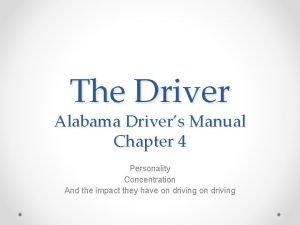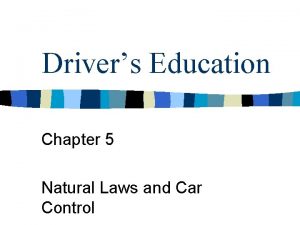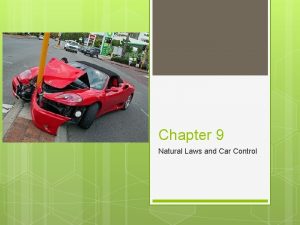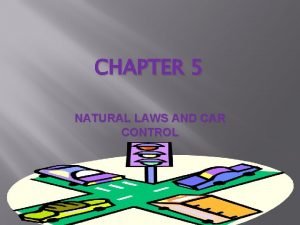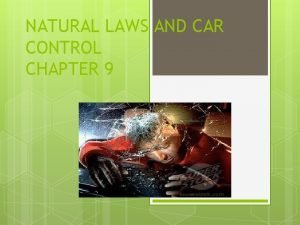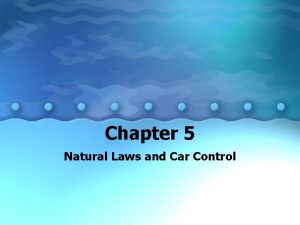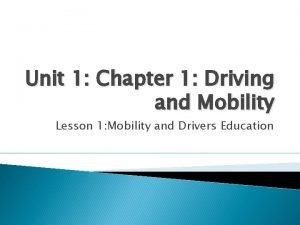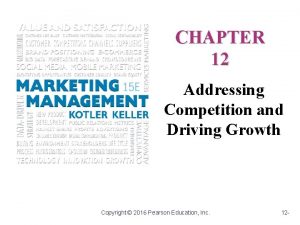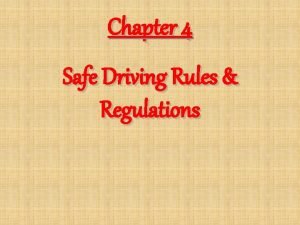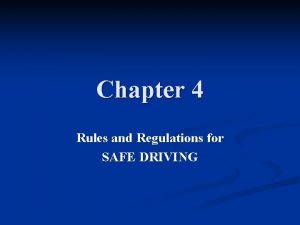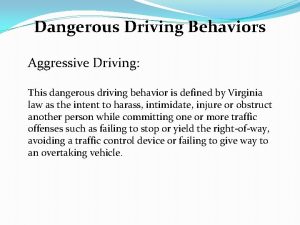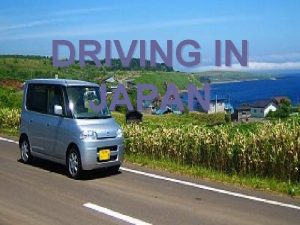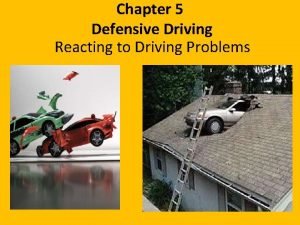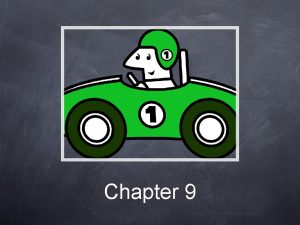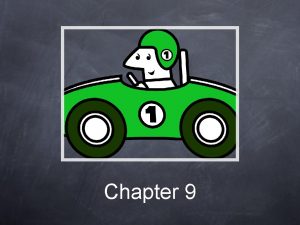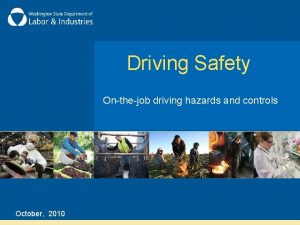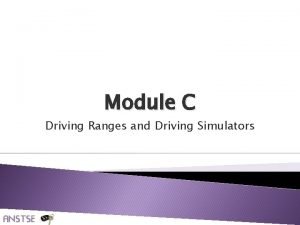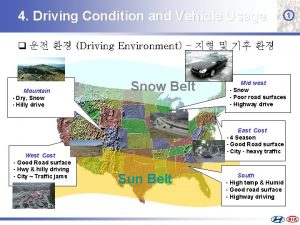Chapter 14 Natural Laws and Driving Natural Laws













- Slides: 13

Chapter 14 Natural Laws and Driving

Natural Laws �Natural Laws are ALWAYS at work �Inertia �Friction �Momentum �Kinetic energy �Gravity

Inertia �Two properties govern inertia: �- Objects at rest do not move unless some force acts on them. �Moving objects continue to move in a straight line unless some force acts on them. � 3 parts of the crash- Vehicle, body, internal organs.

Friction �Friction occurs when two surfaces, such as a tire and the pavement, rub together. We call the friction between a tire and the road traction. The condition of your tires and the road’s surface, as well as curves in the road, can affect traction

Factors that affect traction �Tire pressure �Tire condition �Rain �Ice and Snow �Road Condition

Momentum �Momentum is the product of weight and speed. All objects in motion have momentum. The greater the momentum of vehicles, the greater the damage in a collision will be. �The vehicles momentum depend on its weight and speed. �Weight/speed doubles=double momentum

Gravity and Kinetic Energy �Gravity is the force that pulls all things to Earth. It affects driving up and down hills as well as taking turns. The vehicle’s energy of motion, Kinetic Energy, increases as the vehicle increases in weight and speed. �Kinetic Energy is the energy of motion. �Faster a vehicle moves, the more energy of motion it has.

Center of Gravity �Gravity gives objects their weight. The weight of an object distributed evenly about a point. �The lower an object’s center of gravity, the more stable the object �How would changes in a vehicles center of gravity affect its stability?

Steering and Braking �Total stopping distance is comprised of three parts: 1. Perception Distance 2. Reaction Distance 3. Braking Distance The four-second rule will help you estimate stopping distance, but the actual total braking distance will be affected by speed, vehicle condition, road surface, driver ability, antilock brakes, hills, and vehicle load.

Natural laws that affect steering �Ability to steer depends on steering mechanism, tires, and suspension. �Wheel alignment and road conditions

�What does it mean to skid �Lose control of the direction of speed of your vehicle’s movement because of reduced traction. �What can make your vehicle skid? �Reduced Traction- Change in conditions, your tires can lose their grip on the road’s surface=sliding �Changing speed to quickly (esp. on a slippery road) �Changing direction too quickly- Ex: Large football player trying to make a sharp turn at a full sprint. � How fast is too fast? Depends on the road. Chapter 6 pg 104 Advisory speed limits (Roads that are not straight/flat), Fixed Speed limits (Max and Min), day and night speed limits

Kinds of Skids �Braking- Brakes are applied so hard that one or more wheels lock. Locking of wheels will reduce traction and cause loss of steering control. �Power- Gas pedal is pressed suddenly and too hard. �Cornering- Tires lose traction in a turn. Lose steering control in a turn, curve or lane change �Blowout- Tire suddenly loses air pressure.

Risk Managements and Collisions �Braking is a natural reaction to avoid a collision. However, it is not always the correct action. �Accelerating- may reduce your risk. Situationsmost often occur at intersections or merging in traffic. A vehicle may be coming at you from one side, if you brake you may be in that vehicles path, If the road ahead is clear, a quick burst of speed by accelerating, may take you to safety, or move the crash farther back on the vehicle.
 Texting and driving laws in alabama
Texting and driving laws in alabama Chapter 5 natural laws and car control worksheet answers
Chapter 5 natural laws and car control worksheet answers Natural laws and car control quiz
Natural laws and car control quiz When an object moves, it acquires
When an object moves, it acquires A vehicle's momentum depends on its
A vehicle's momentum depends on its Chapter 5 natural laws and car control
Chapter 5 natural laws and car control Administrative and traffic laws
Administrative and traffic laws Facts about montesquieu
Facts about montesquieu Crash costs are measured in dollars and in
Crash costs are measured in dollars and in What effect might alcohol and another drug
What effect might alcohol and another drug Chapter 12 addressing competition and driving growth
Chapter 12 addressing competition and driving growth Motorist
Motorist Chapter 4 safe driving rules and regulations
Chapter 4 safe driving rules and regulations Chapter 4 safe driving rules and regulations
Chapter 4 safe driving rules and regulations
